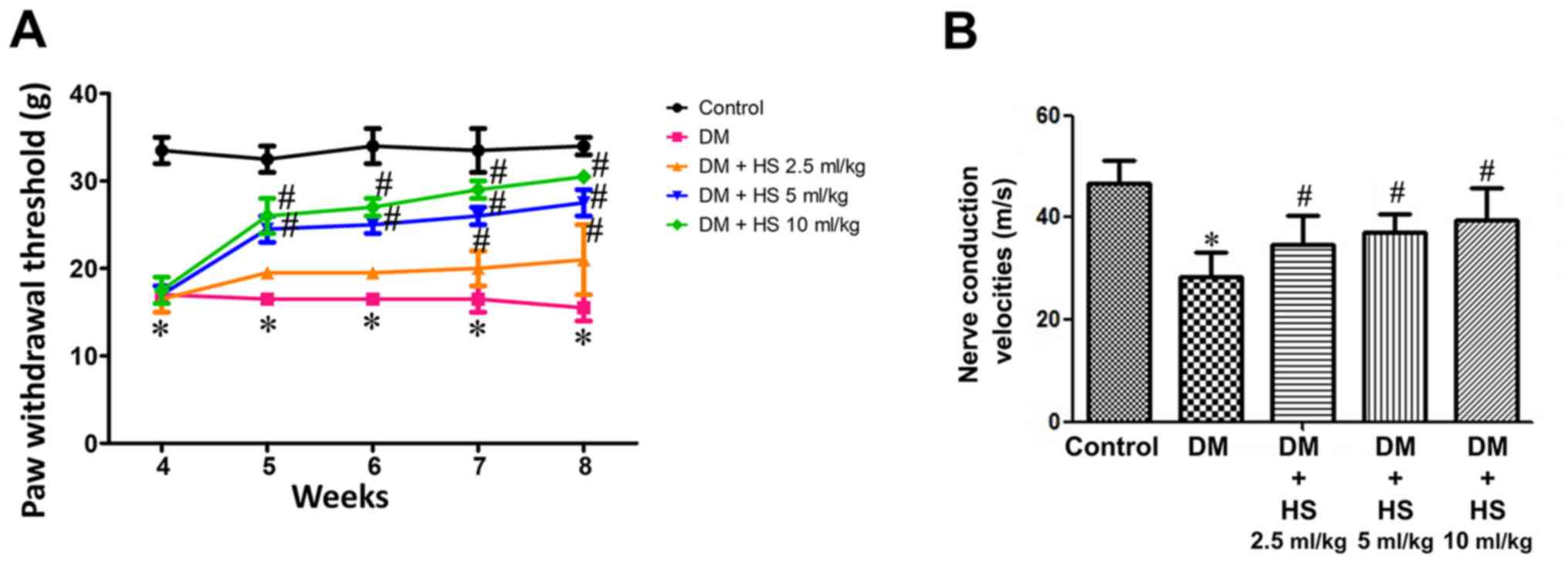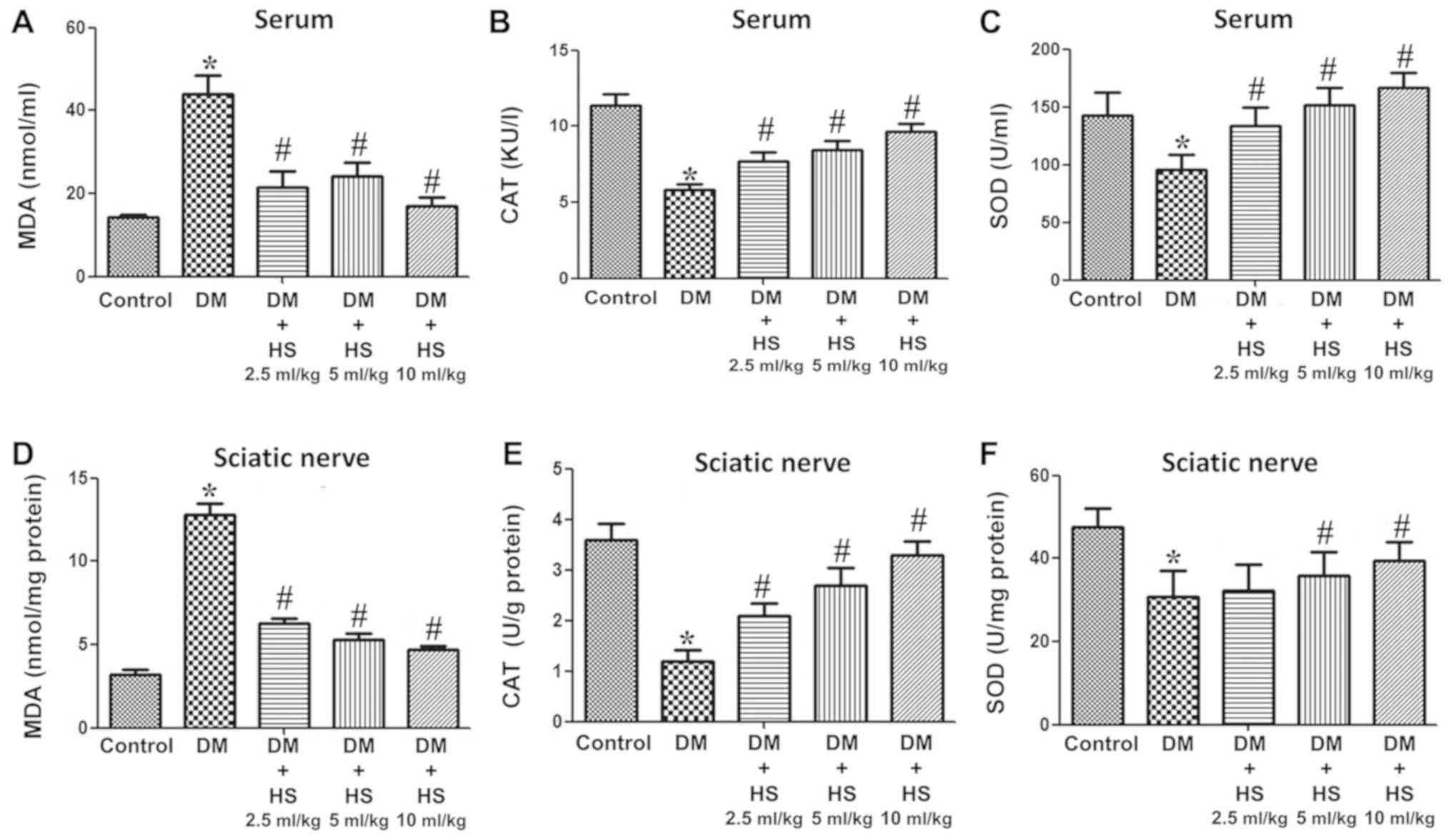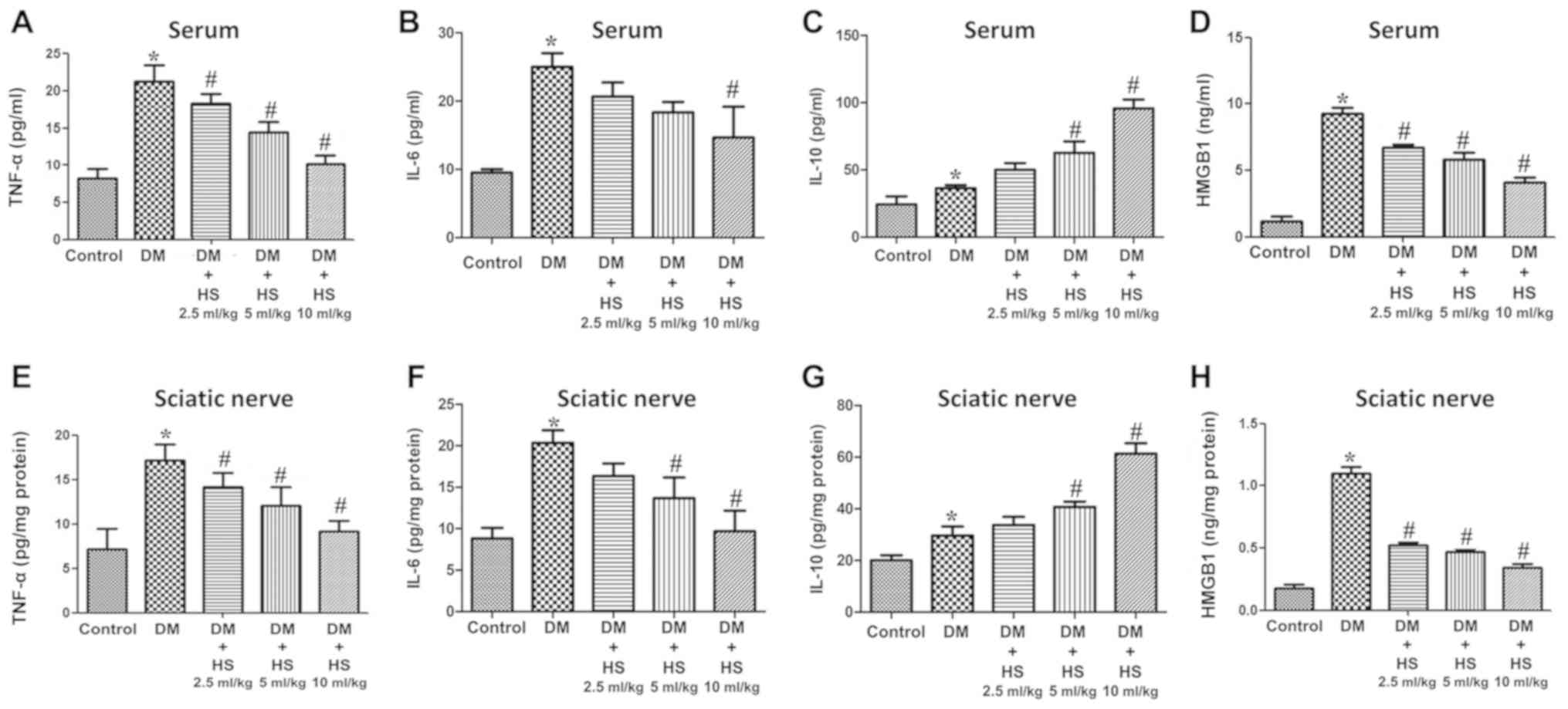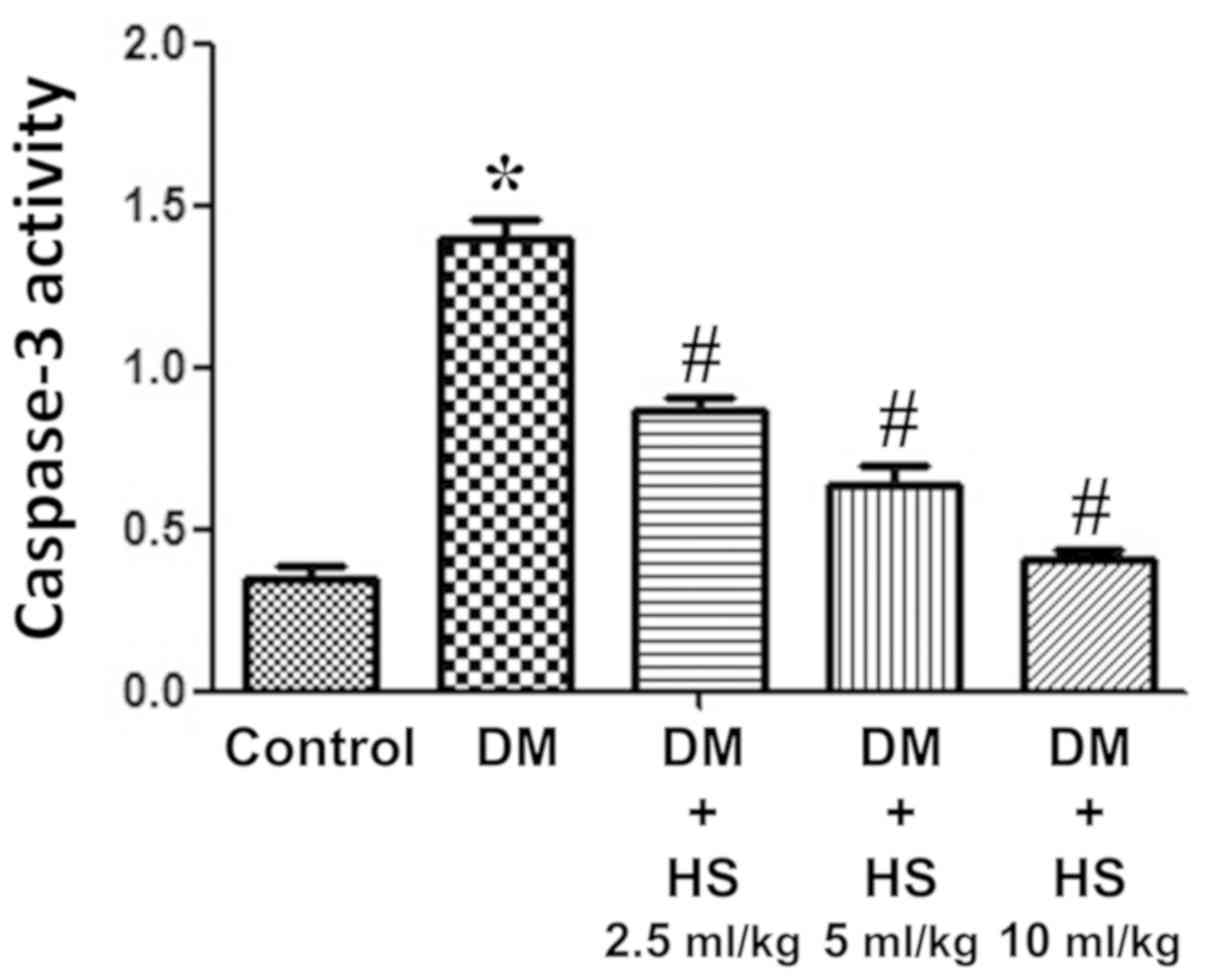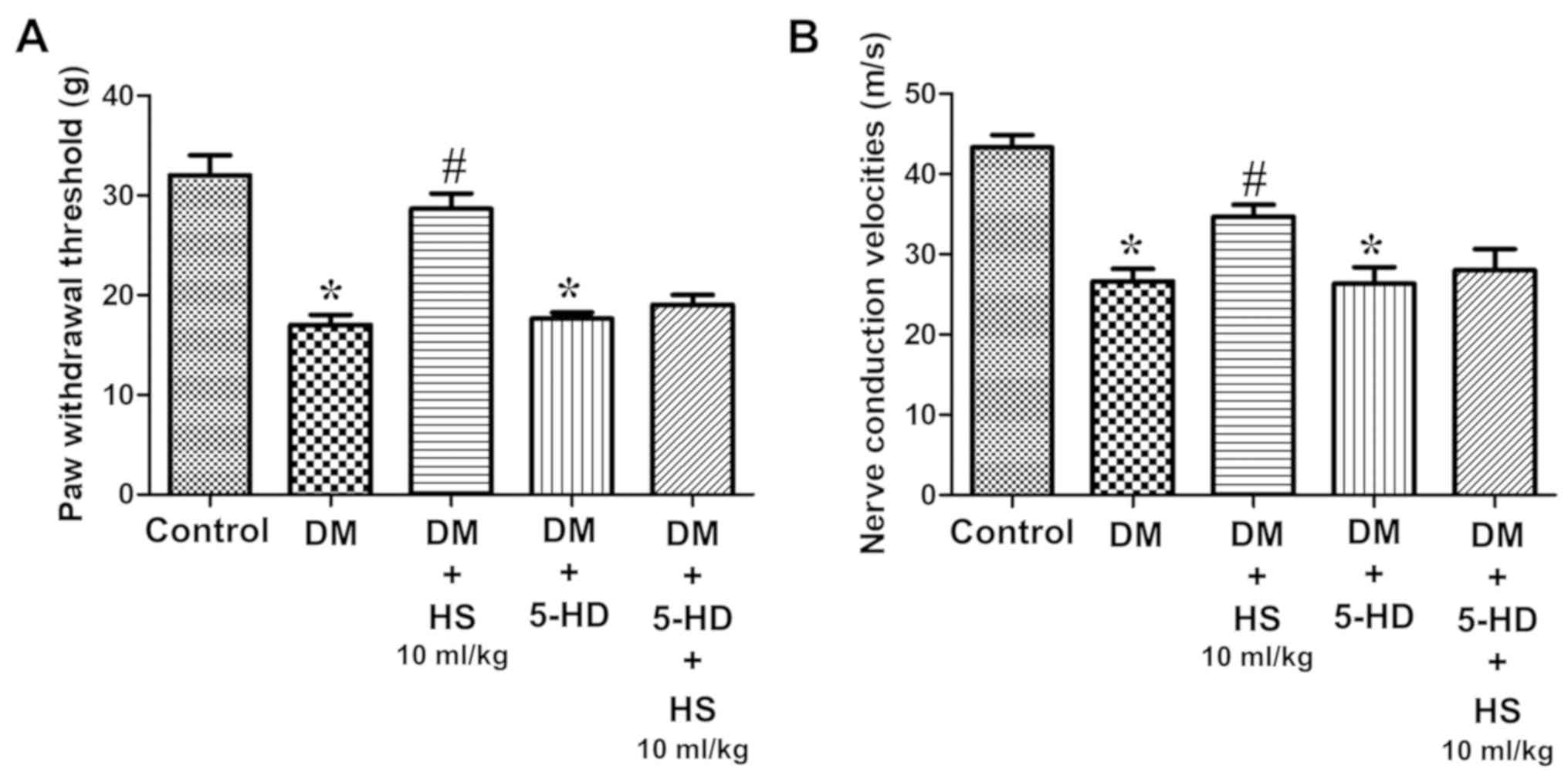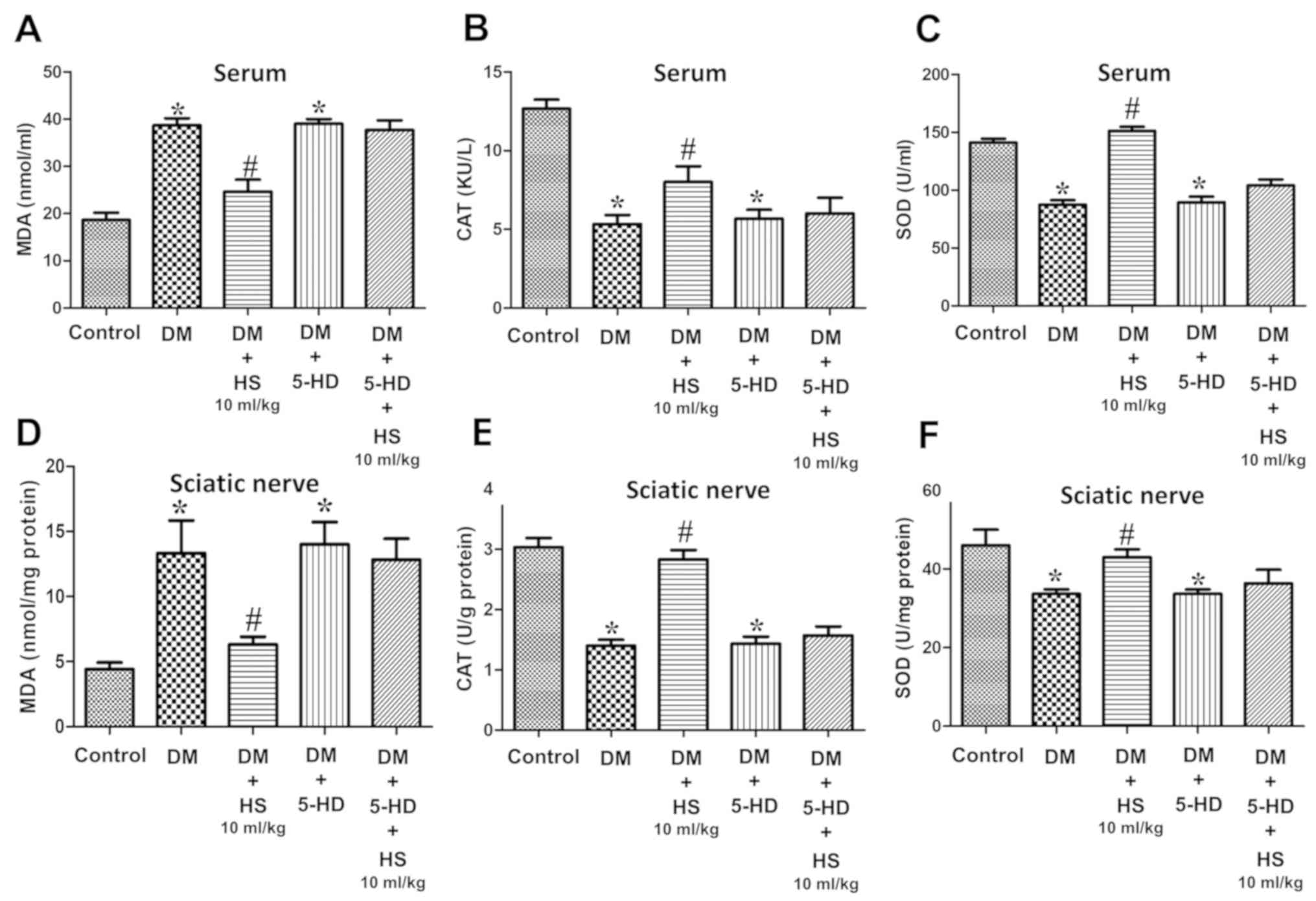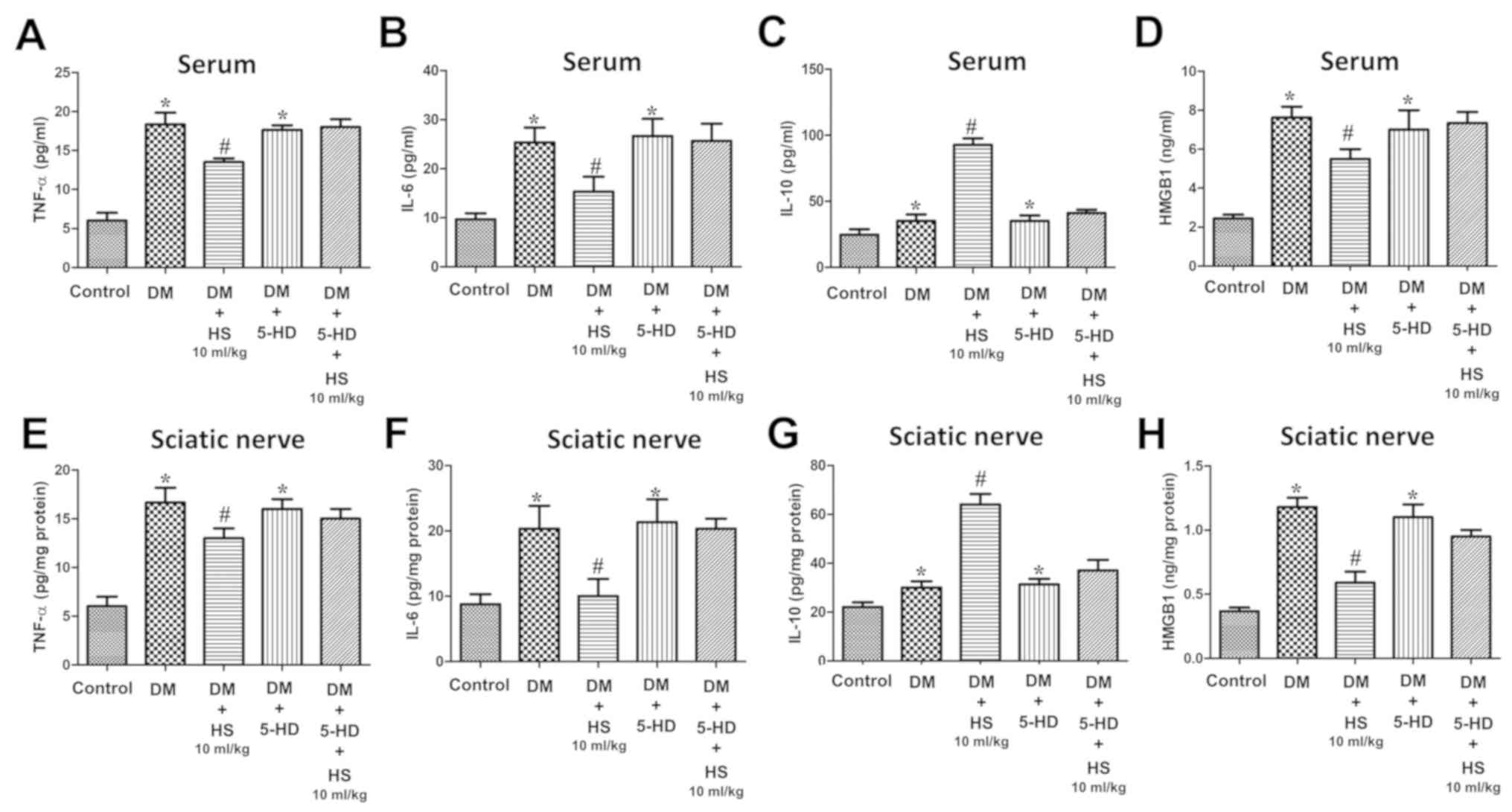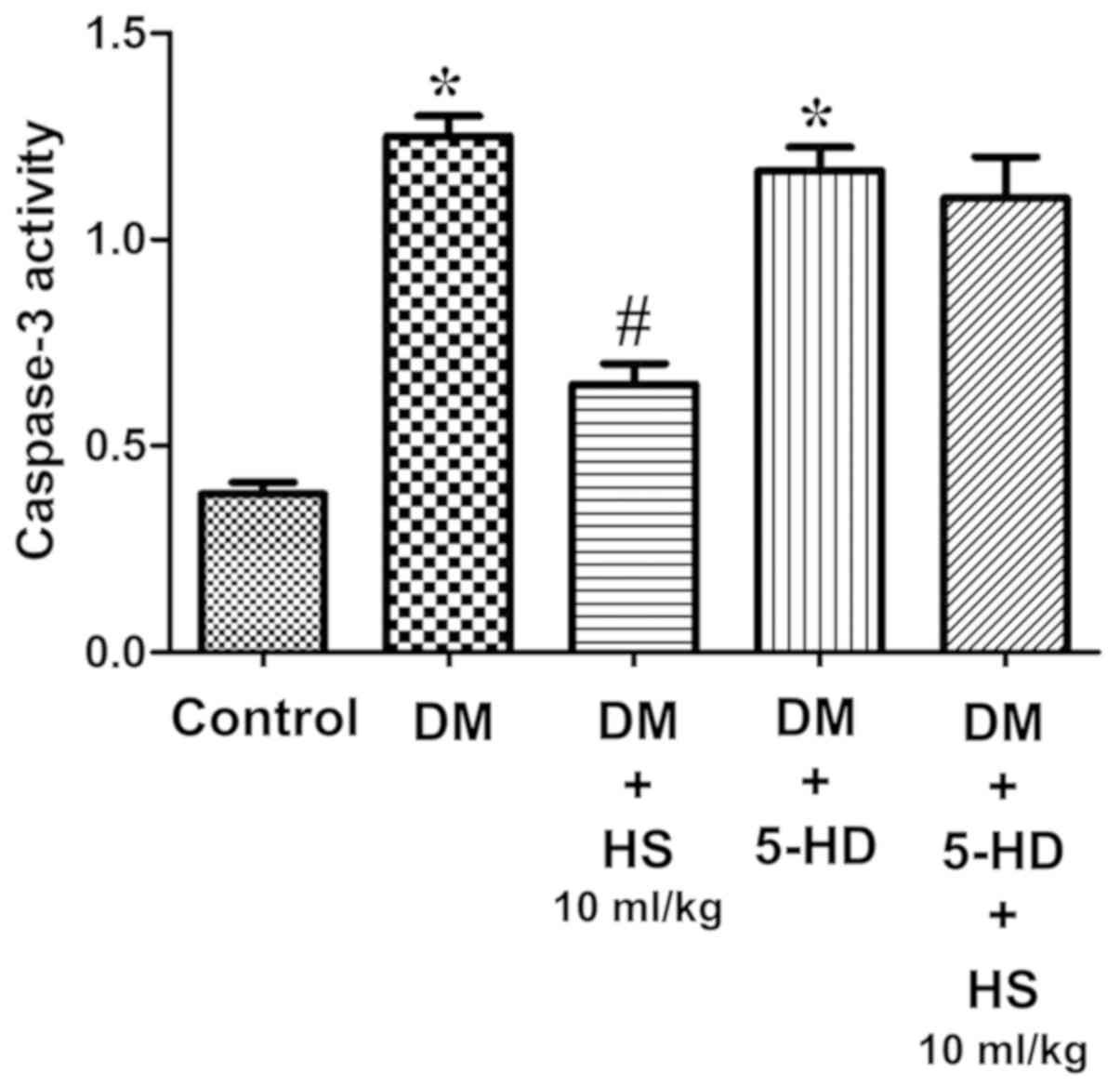|
1
|
Chung YC, Lim JH, Oh HM, Kim HW, Kim MY,
Kim EN, Kim Y, Chang YS, Kim HW and Park CW: Calcimimetic restores
diabetic peripheral neuropathy by ameliorating apoptosis and
improving autophagy. Cell Death Dis. 9:11632018. View Article : Google Scholar : PubMed/NCBI
|
|
2
|
Wang LQ, Chen Z, Zhang K, Liang N, Yang
GY, Lai L and Liu JP: Zusanli (ST36) acupoint injection for
diabetic peripheral neuropathy: A systematic review of randomized
controlled trials. J Altern Complement Med. Sep 26–2018.(Epub ahead
of print). View Article : Google Scholar
|
|
3
|
Alam U, Riley DR, Jugdey RS, Azmi S,
Rajbhandari S, D'Août K and Malik RA: Diabetic neuropathy and gait:
A review. Diabetes Ther. 8:1253–1264. 2017. View Article : Google Scholar : PubMed/NCBI
|
|
4
|
Vinik AI, Camacho P, Reddy S, Valencia WM,
Trence D, Matsumoto AM and Morley JE: Aging, Diabetes, and Falls.
Endocr Pract. 23:1117–1139. 2017. View Article : Google Scholar : PubMed/NCBI
|
|
5
|
Li K, Shi X, Luo M, Inam-U-Llah, Wu P,
Zhang M, Zhang C, Li Q, Wang Y and Piao F: Taurine protects against
myelin damage of sciatic nerve in diabetic peripheral neuropathy
rats by controlling apoptosis of schwann cells via NGF/Akt/GSK3β
pathway. Exp Cell Res. 383:1115572019. View Article : Google Scholar : PubMed/NCBI
|
|
6
|
Montero AR, Dubin JS, Sack P and Magee MF:
Future technology-enabled care for diabetes and hyperglycemia in
the hospital setting. Wold J Diabetes. 10:473–480. 2019. View Article : Google Scholar
|
|
7
|
Li Q, Jiao Y and Yu Y, Wang G and Yu Y:
Hydrogen-rich medium alleviates high glucose-induced oxidative
stress and parthanatos in rat Schwann cells in vitro. Mol
Med Rep. 19:338–344. 2019.PubMed/NCBI
|
|
8
|
Liang W, Chen M, Zheng D, Li J, Song M,
Zhang W, Feng J and Lan J: The opening of ATP-sensitive K+ channels
protects H9c2 cardiac cells against the high glucose-induced injury
and inflammation by inhibiting the ROS-TLR4-necroptosis pathway.
Cell Physiol Biochem. 41:1020–1034. 2017. View Article : Google Scholar : PubMed/NCBI
|
|
9
|
Shi N, He J, Guo Q, Liu T and Han J:
Liraglutide protects against diabetes mellitus complicated with
focal cerebral ischemic injury by activating mitochondrial
ATP-sensitive potassium channels. Neuroreport. 30:479–484. 2019.
View Article : Google Scholar : PubMed/NCBI
|
|
10
|
Rojas DR, Tegeder I, Kuner R and Agarwal
N: Hypoxia-inducible factor 1α protects peripheral sensory neurons
from diabetic peripheral neuropathy by suppressing accumulation of
reactive oxygen species. J Mol Med (Berl). 96:1395–1405. 2018.
View Article : Google Scholar : PubMed/NCBI
|
|
11
|
Fu Y, Ito M, Fujita Y, Ito M, Ichihara M,
Masuda A, Suzuki Y, Maesawa S, Kajita Y, Hirayama M, et al:
Molecular hydrogen is protective against 6-hydroxydopamine-induced
nigrostriatal degeneration in a rat model of Parkinson's disease.
Neurosci Lett. 453:81–85. 2009. View Article : Google Scholar : PubMed/NCBI
|
|
12
|
Li J, Dong Y, Chen H, Han H, Yu Y, Wang G,
Zeng Y and Xie K: Protective effects of hydrogen-rich saline in a
rat model of permanent focal cerebral ischemia via reducing
oxidative stress and inflammatory cytokines. Brain Res.
1486:103–111. 2012. View Article : Google Scholar : PubMed/NCBI
|
|
13
|
Chen H, Xie K, Chen Y, Wang Y, Wang Y,
Lian N, Zhang K and Yu Y: Nrf2/HO-1 signaling pathway participated
in the protection of hydrogen sulfide on neuropathic pain in rats.
Int Immunopharmacol. 75:1057462019. View Article : Google Scholar : PubMed/NCBI
|
|
14
|
Wang H, Huo X, Chen H, Li B, Liu J, Ma W,
Wang X, Xie K, Yu Y and Shi K: Hydrogen-rich saline activated
autophagy via HIF-1α pathways in neuropathic pain model. Biomed Res
Int. 2018:46708342018.PubMed/NCBI
|
|
15
|
Xin Y, Liu H, Zhang P, Chang L and Xie K:
Molecular hydrogen inhalation attenuates postoperative cognitive
impairment in rats. Neuroreport. 28:694–700. 2017. View Article : Google Scholar : PubMed/NCBI
|
|
16
|
Dong A, Yu Y, Wang Y, Li C, Chen H, Bian
Y, Zhang P, Zhao Y, Yu Y and Xie K: Protective effects of hydrogen
gas against sepsis-induced acute lung injury via regulation of
mitochondrial function and dynamics. Int Immunopharmacol.
65:366–372. 2018. View Article : Google Scholar : PubMed/NCBI
|
|
17
|
Hedenstierna G: Mechanisms of
postoperative pulmonary dysfunction. Acta Chir Scand Suppl.
550:152–158. 1989.PubMed/NCBI
|
|
18
|
Yang T, Wang L, Sun R, Chen H, Zhang H, Yu
Y, Wang Y, Wang G, Yu Y and Xie K: Hydrogen-rich medium ameliorates
lipopolysaccharide-induced barrier dysfunction via rhoa-Mdia1
signaling in Caco-2 Cells. Shock. 45:228–237. 2016. View Article : Google Scholar : PubMed/NCBI
|
|
19
|
Ohsawa I, Ishikawa M, Takahashi K,
Watanabe M, Nishimaki K, Yamagata K, Katsura K, Katayama Y, Asoh S
and Ohta S: Hydrogen acts as a therapeutic antioxidant by
selectively reducing cytotoxic oxygen radicals. Nat Med.
13:688–694. 2007. View
Article : Google Scholar : PubMed/NCBI
|
|
20
|
Chen J, Zhang H, Hu J, Gu Y, Shen Z, Xu L,
Jia X, Zhang X and Ding X: Hydrogen-rich saline alleviates kidney
fibrosis following AKI and retains klotho expression. Front
Pharmacol. 8:4992017. View Article : Google Scholar : PubMed/NCBI
|
|
21
|
Yang C, Gao J, Wu B, Yan N, Li H, Ren Y,
Kan Y, Liang J, Jiao Y and Yu Y: Minocycline attenuates the
development of diabetic neuropathy by inhibiting spinal cord Notch
signaling in rat. Biomed Pharmacother. 94:380–385. 2017. View Article : Google Scholar : PubMed/NCBI
|
|
22
|
Xu Z, Zhou J, Cai J, Zhu Z, Sun X and
Jiang C: Anti-inflammation effects of hydrogen saline in LPS
activated macrophages and carrageenan induced paw oedema. J Inflamm
(Lond). 9:22012. View Article : Google Scholar : PubMed/NCBI
|
|
23
|
Parashar A, Mehta V and Malairaman U: Type
2 diabetes mellitus is associated with social recognition memory
deficit and altered dopaminergic neurotransmission in the amygdala.
Ann Neurosci. 24:212–220. 2018. View Article : Google Scholar : PubMed/NCBI
|
|
24
|
Reis R, Charehsaz M, Sipahi H, Ekici AI,
Macit Ç, Akkaya H and Aydın A: Energy drink induced lipid
peroxidation and oxidative damage in rat liver and brain when used
alone or combined with alcohol. J Food Sci. 82:1037–1043. 2017.
View Article : Google Scholar : PubMed/NCBI
|
|
25
|
Barany T, Simon A, Szabo G, Benkő R, Mezei
Z, Molnár L, Becker D, Merkely B, Zima E and Horváth EM: Oxidative
stress-related parthanatos of circulating mononuclear leukocytes in
heart failure. Oxid Med Cell Longev. 2017:12496142017. View Article : Google Scholar : PubMed/NCBI
|
|
26
|
Kobayashi M and Zochodne DW: Diabetic
neuropathy and the sensory neuron: New aspects of pathogenesis and
their treatment implications. J Diabetes Investig. 9:1239–1254.
2018. View Article : Google Scholar : PubMed/NCBI
|
|
27
|
Sherchan P, Huang L, Wang Y, Akyol O, Tang
J and Zhang JH: Recombinant Slit2 attenuates neuroinflammation
after surgical brain injury by inhibiting peripheral immune cell
infiltration via Robo1-srGAP1 pathway in a rat model. Neurobiol
Dis. 85:164–173. 2016. View Article : Google Scholar : PubMed/NCBI
|
|
28
|
Xie K, Yu Y, Pei Y, Hou L, Chen S, Xiong L
and Wang G: Protective effects of hydrogen gas on murine
polymicrobial sepsis via reducing oxidative stress and HMGB1
release. Shock. 34:90–97. 2010. View Article : Google Scholar : PubMed/NCBI
|
|
29
|
Wang X, Feng C, Qiao Y and Zhao X: Sigma 1
receptor mediated HMGB1 expression in spinal cord is involved in
the development of diabetic neuropathic pain. Neurosci Lett.
668:164–168. 2018. View Article : Google Scholar : PubMed/NCBI
|
|
30
|
Yang X, Yao W, Shi H, Liu H, Li Y, Gao Y,
Liu R and Xu L: Paeoniflorin protects Schwann cells against high
glucose induced oxidative injury by activating Nrf2/ARE pathway and
inhibiting apoptosis. J Ethnopharmacol. 185:361–369. 2016.
View Article : Google Scholar : PubMed/NCBI
|
|
31
|
Roman-Pintos LM, Villegas-Rivera G,
Rodriguez-Carrizalez AD, Miranda-Diaz AG and Cardona-Munoz EG:
Diabetic polyneuropathy in type 2 diabetes mellitus: Inflammation,
oxidative stress, and mitochondrial function. J Diabetes Res.
2016:34256172016. View Article : Google Scholar : PubMed/NCBI
|
|
32
|
Meng X, Chen H, Wang G, Yu Y and Xie K:
Hydrogen-rich saline attenuates chemotherapy-induced ovarian injury
via regulation of oxidative stress. Exp Ther Med. 10:2277–2282.
2015. View Article : Google Scholar : PubMed/NCBI
|
|
33
|
Liu H, Hua N, Xie K, Zhao T and Yu Y:
Hydrogen-rich saline reduces cell death through inhibition of DNA
oxidative stress and overactivation of poly (ADP-ribose)
polymerase-1 in retinal ischemia-reperfusion injury. Mol Med Rep.
12:2495–2502. 2015. View Article : Google Scholar : PubMed/NCBI
|















